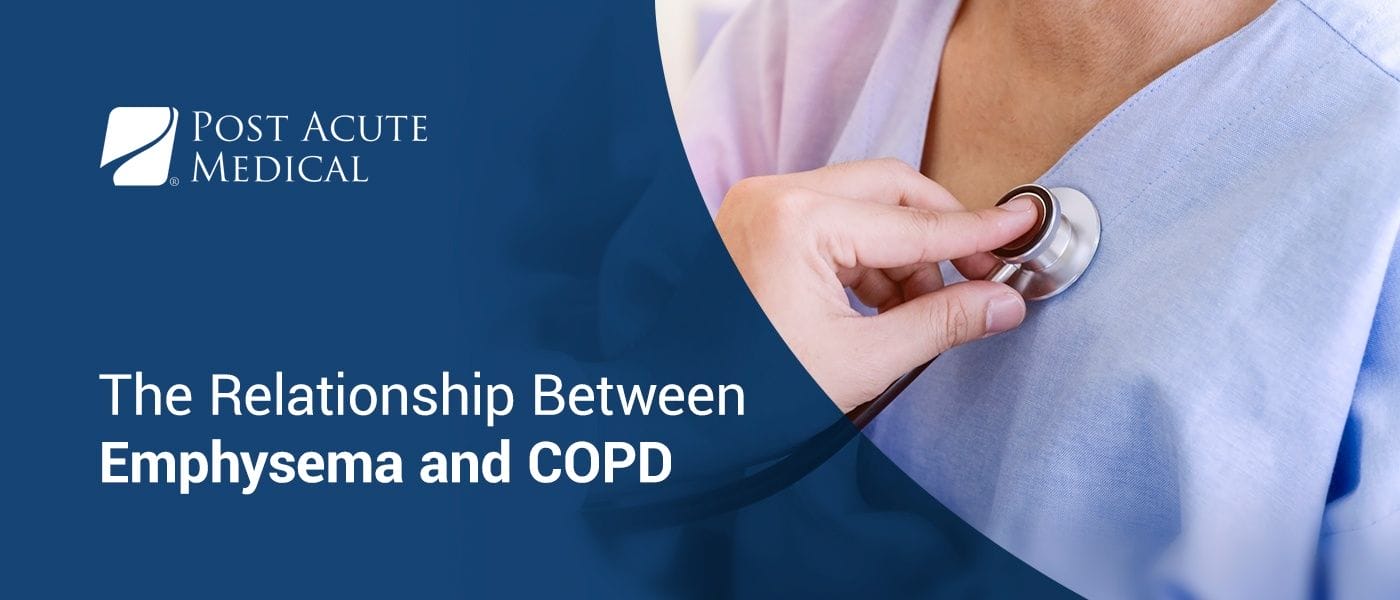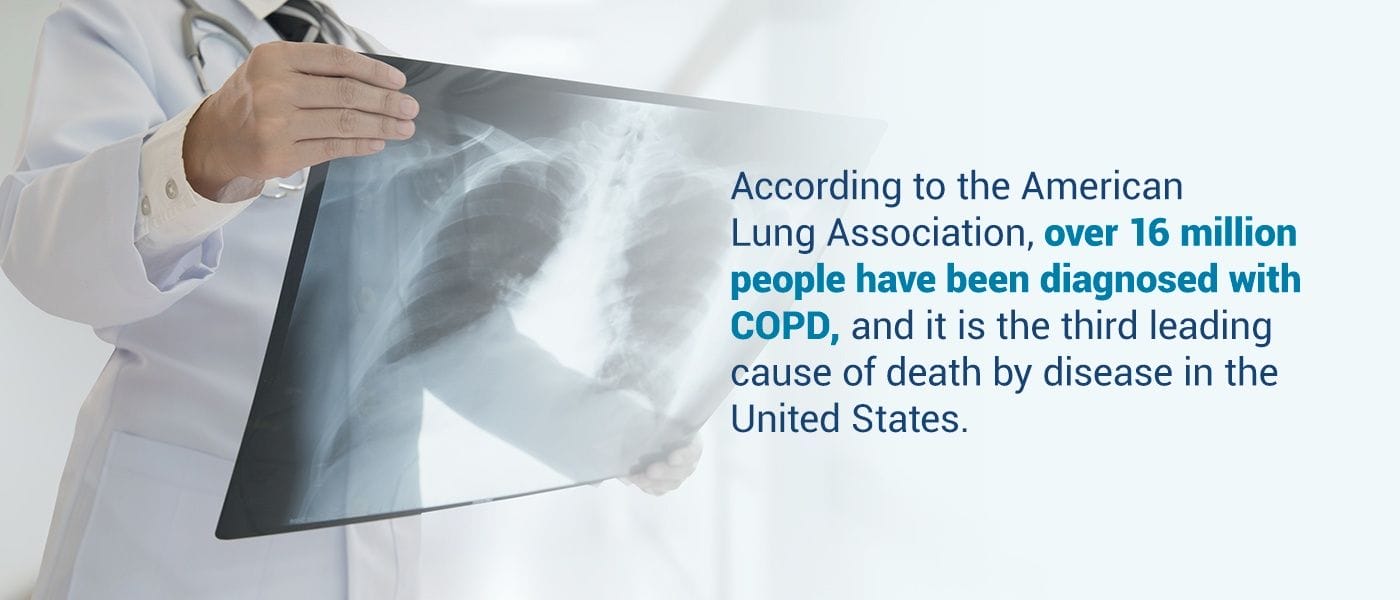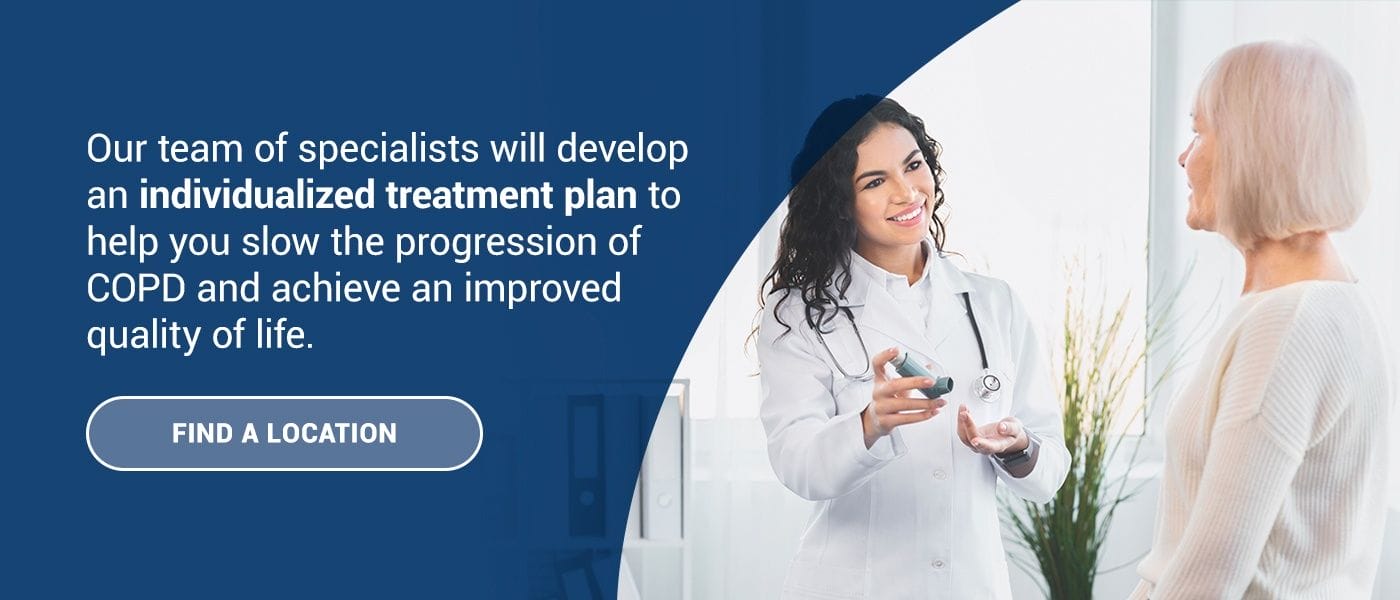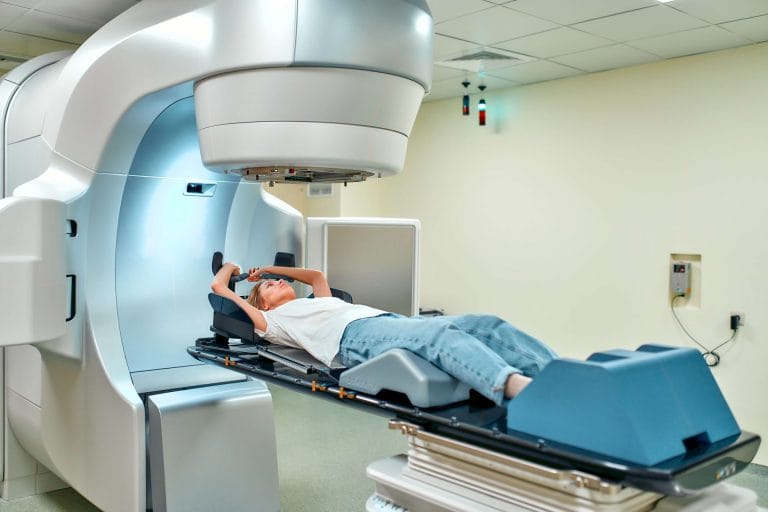
If you or a loved one were recently diagnosed with emphysema or COPD, you might be wondering — what is the difference between the two? Do they mean the same thing?
Medical terminology can be confusing to anyone. Still, it is crucial to understand your diagnosis to take the right steps toward feeling better. In this post, we hope to clear up some of the confusion and explore the meaning of COPD and emphysema. If you have questions or concerns along the way, please reach out to us. Our medical professionals are ready to help you live a healthier, happier life.
Explore Cardiopulmonary Rehabilitation Offered by PAM Health

What Is COPD?
Chronic obstructive pulmonary disease (COPD) is a term that refers to a group of lung diseases. According to the American Lung Association, over 16 million people have been diagnosed with COPD, and it is the third leading cause of death by disease in the United States. Many people have COPD but have not yet been diagnosed.
Chronic bronchitis and emphysema are the most common forms of COPD. Chronic bronchitis makes it hard to breathe because swelling or extra mucus blocks the airways in your lungs. With emphysema, the air sacs in your lungs are damaged, making it more difficult to get oxygen from the air and causing shortness of breath.
Most people with COPD have both emphysema and chronic bronchitis, though the severity varies depending on the individual. Since each person experiences emphysema and chronic bronchitis differently, doctors prefer to use the term COPD to describe these diseases.
What Are the Symptoms of COPD?
COPD is a progressive disease, meaning it gets worse over time. In the beginning, you may not notice any symptoms, or you might experience mild issues until the disease progresses. Common COPD symptoms include:
- Shortness of breath
- Wheezing
- Frequent coughing
- Chest tightness
It is possible to have COPD and not experience any of the above symptoms. Likewise, COPD can cause ankle swelling or weight loss, which often occur with other diseases. If you have another disease, like diabetes or heart disease, it can impact how you experience COPD.
If you have COPD symptoms or see signs of lung disease in a loved one, it is vital to get evaluated by a doctor. Early prevention and treatment are key to relieving symptoms and slowing the progression of COPD.
COPD Stages
Doctors classify COPD in four different stages: mild, moderate, severe and very severe. Your doctor can determine your COPD stage based on a lung functioning test and your symptoms. For example, your physician might use a spirometry test to assess lung functioning and determine your COPD stage. A spirometry test measures how much air you can breathe out in a single breath and how fast you can exhale the air.
During a spirometry test, you will breathe out all the air in your lungs into a device called a spirometer. This device calculates the amount of air you exhale in the first second and the total amount of air you breathe out. These measurements are compared to individuals of the same age and height with healthy lungs. The numbers are represented as “forced expiratory volume in the first second” and “forced vital capacity.” Based on your test results, the level of COPD you have will be classified in the following ways:
- Stage 1(mild): With mild COPD, you will have a forced expiratory volume above 80%. This means you may not notice symptoms of COPD yet. Some people with mild COPD experience shortness of breath after exercise or a nagging cough.
- Stage 2 (moderate): With moderate COPD, you will have a forced expiratory volume of 50% to 80%. During this stage, you may experience a chronic cough, wheezing, shortness of breath and excess mucus. This is when many patients go to the doctor for an evaluation because COPD starts to impact their lives.
- Stage 3 (severe): If you have severe COPD, your forced expiratory volume will be between 30% and 50%. During this stage, you may feel tired or sick or have a chronic cough. Earlier symptoms tend to get worse during this stage. You may also have more frequent chest infections. Severe COPD makes it difficult to exercise or complete daily activities.
- Stage 4 (very severe): During the final stage of COPD, you will have a forced expiratory volume of less than 30%. Very severe COPD can significantly impact your life and make it difficult to breathe without exertion. You might experience a range of symptoms related to breathing issues, such as difficulty walking or eating. You may also experience more flare-ups and need to go to the hospital more often for longer periods. Flare-ups occur when COPD symptoms suddenly worsen.
Although the different COPD stages can help you figure out how far the disease has progressed, they are only guides. Your doctor needs to consider your unique symptoms in addition to spirometry test results to determine the most appropriate treatment for your needs.

Are Emphysema and COPD the Same Thing?
Although emphysema and COPD may be used interchangeably, they do not have the same meaning. Emphysema is a type of COPD. COPD is a term that may be used in reference to various lung diseases, such as emphysema, chronic bronchitis or bronchiectasis. In other words, someone might have COPD but not be diagnosed with emphysema.
Emphysema is a common form of COPD that affects the air sacs in the lungs. To envision how emphysema works, first, imagine your lungs. Inside your lungs, you have bronchial tubes. When you breathe in, air passes through your mouth or nose, down your windpipe and through your bronchial tubes. Your bronchial tubes branch out into many smaller tubes called bronchioles. Bronchioles end in clusters of tiny air sacs called alveoli.
With healthy lungs, the alveoli are elastic like small balloons that inflate and deflate as a person breathes in and breathes out. With emphysema, the air sacs and the walls between them are damaged and may be stretched, collapsed, narrowed or destroyed. When the air sacs lose the ability to push air out of the body, the air gets trapped in the lungs and leads to shortness of breath.
How Quickly Does Emphysema Progress?
Emphysema typically progresses slowly, and most people will not notice symptoms until they have been exposed to lung irritants for many years. When someone does begin to see emphysema symptoms, they might first experience shortness of breath during exercise. As the disease progresses, they might have trouble breathing during daily activities, like housework. In an advanced stage, shortness of breath may occur even at rest.
Again, it is important to note that emphysema is not the same for everyone. Some people with mild emphysema might experience shortness of breath, while others with a severe form of the disease may hardly notice their symptoms.
Can Your Lungs Heal From Emphysema?
Lung damage associated with emphysema is irreversible. However, treatment can improve symptoms and keep the disease from getting worse.
Common Causes of COPD and Emphysema
COPD, including emphysema and chronic bronchitis, is usually caused by long-term exposure to lung irritants. Smoking is the leading cause of COPD, with about 85% to 90% of COPD cases attributed to smoking.
However, non-smokers can also get COPD. For example, according to a survey reported by the Centers for Disease Control and Prevention (CDC), about 25% of adults with COPD never smoked but were regularly exposed to irritants in their environment.
Overall, causes of COPD include:
- Smoking: Smoking is the greatest risk factor for developing COPD and emphysema. The more someone smokes, and the longer they smoke, the higher their risk of having COPD. Tobacco smoke contains harmful chemicals that destroy air sacs and causes inflammation. People who smoke pipes, cigars and marijuana are also at risk of developing COPD.
- Environmental pollution: Long-term exposure to pollutants in the air can cause COPD and emphysema. For example, people who work around dust, chemical fumes and vapors may experience regular lung irritation and inflammation, which can contribute to the development of lung disease. Exposure to significant amounts of secondhand hand smoke also increases the risk of COPD.
- Alpha-1 antitrypsin deficiency: In rare cases, emphysema may be caused by an inherited condition called alpha-1 antitrypsin deficiency. This condition affects the body’s production of alpha-1 antitrypsin, which is a protein that protects the lungs. Only about 1% to 2% of COPD cases are caused by alpha-1 antitrypsin deficiency.
- Asthma: Some people with asthma, an inflammatory lung disease, may develop COPD. When asthma and COPD occur together, this is known as asthma-COPD overlap syndrome. This syndrome typically occurs in people who smoke and have asthma.
What Happens If You Have Emphysema and Keep Smoking?
If you have emphysema and continue to smoke, the disease will progress much faster than if you quit. That is why it is never too late to quit smoking.

Medical Treatments for COPD and Emphysema
If you or a loved one have COPD or emphysema, know there is hope. You can slow the progression of COPD and emphysema and get back to doing the activities you enjoy. Even if you have an advanced COPD stage, you can still manage symptoms, slow disease progression and increase your activity levels.
It is essential to reduce or eliminate your exposure to the irritant damaging your lungs, such as tobacco smoke or environmental toxins, to keep COPD from rapidly progressing. Secondly, it is critical to meet with a medical professional as soon as possible so you can get treatment. A medical professional will evaluate your needs and situation and come up with an individualized treatment plan.
Although your treatment plan depends on your symptoms and overall condition, some options include:
- Smoking cessation: Quitting smoking is the most important step you can take to keep COPD and emphysema from getting worse. However, quitting smoking can be extremely challenging to do on your own. If you are ready to give up smoking, speak with your doctor and devise a plan. By preparing to quit smoking, you can set yourself up for success.
- Bronchodilators: Bronchodilators are medications that relax the muscles in the lungs and widen the airways, making it easier to breathe. Bronchodilators might be inhaled or taken orally. Doctors may prescribe bronchodilators as an initial form of treatment for COPD or emphysema.
- Steroids: If you experience a flare-up, your doctor may prescribe steroids to reduce inflammation. Like bronchodilators, steroids might be inhaled or taken orally, depending on your needs. Some medications combine bronchodilators with steroids.
- Antibiotics: If a respiratory infection causes a flare-up, your doctor may give you antibiotics. Infections such as acute bronchitis, influenza and pneumonia can make COPD and emphysema symptoms worse. Your physician may also recommend that you get a flu shot and pneumonia shot to help prevent infections.
- Oxygen therapy: If you have moderate or severe COPD, your doctor might use oxygen therapy to ensure you get enough oxygen. Various devices are available to help you breathe and get oxygen into your lungs, including light and portable units you can easily carry around. Depending on your needs, you might use supplemental oxygen only during activities, or you may need it all of the time. Your doctor will determine what is best for you.
- Pulmonary rehabilitation: Pulmonary rehabilitation is a personalized program that teaches you how to improve your breathing and keep symptoms from getting worse. Your program might include breathing techniques, a suitable exercise plan, nutrition counseling, strength training, relaxation therapy and any other therapy service needed to increase your comfort and independence.
Here are a few general tips to help you manage COPD symptoms at home:
- Get plenty of sleep, and rest before and after activities.
- Practice frequent hand-washing to help prevent respiratory infections.
- Follow a nutritious diet and try to maintain a healthy weight.
- Drink plenty of water and consider using a humidifier to clear your airways.
- Avoid secondhand smoke and air pollution.

Contact Post Acute Medical
Having COPD or emphysema does not mean your life is over. You can live a long and satisfying life with COPD by avoiding lung irritants and managing your symptoms. At Post Acute Medical, we are here to help you breathe easier, today and tomorrow.
Post Acute Medical is an inpatient and outpatient rehabilitation center with a focus on putting patients first. With our Cardiopulmonary Program, our team of specialists will develop an individualized treatment plan to help you slow the progression of COPD and achieve an improved quality of life. Please reach out to us at your nearest Post Acute Medical facility to start treatment for COPD and emphysema.


